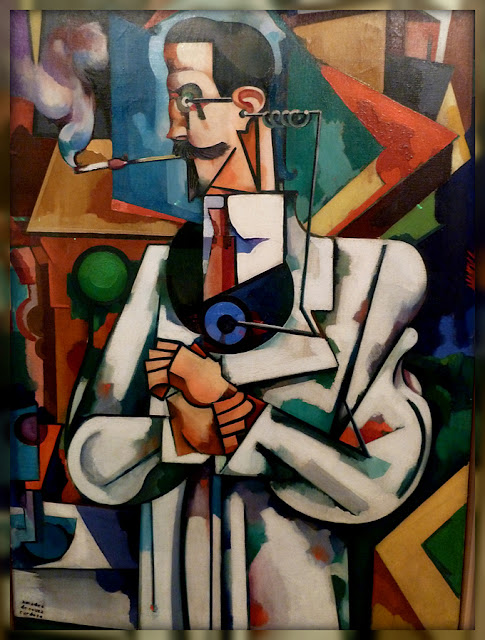Amadeo de Souza-Cardoso (14 November 1887 – 25 October 1918) was a Portuguese painter.
His early works, under the tutelage of the Spanish painter Anglada Camarasa, were stylistically close to impressionism. Around 1910, influenced both by cubism and by futurism, he became one of the first modern Portuguese painters. His style is aggressive and vivid both in form and colour and his works may seem random or chaotic in their compositional structure at first sight but are clearly defined and balanced. His more innovative paintings, such as "Trou de la Serrure", resemble collages and seem to pave the way to abstractionism or even dadaism.
His early works, under the tutelage of the Spanish painter Anglada Camarasa, were stylistically close to impressionism. Around 1910, influenced both by cubism and by futurism, he became one of the first modern Portuguese painters. His style is aggressive and vivid both in form and colour and his works may seem random or chaotic in their compositional structure at first sight but are clearly defined and balanced. His more innovative paintings, such as "Trou de la Serrure", resemble collages and seem to pave the way to abstractionism or even dadaism.
In 1912 he published an album with twenty drawings, and copied the story of Gustave Flaubert, “La Légende de Saint Julien to l'Hospitalier”, in a calligraphic manuscript with illustrations, but these early works attracted little notice. In 1913 he exhibited eight works in the Armory Show in the USA, some of which are now in American museums. The following year, he returned to Portugal and initiated a great and meteoric career in the experimentation of new forms of expression.
In 1915 Amadeo and other artists such as Santa-Rita, Fernando Pessoa and Mário de Sá-Carneiro joined to shape Orpheu, a magazine which had only two editions and is considered by many to be the exponent of Portuguese modernism. Amadeo also participated in another magazine, Portugal Futurista, which had only one edition published. In 1916, he displayed in Oporto 114 artworks with the heading “Abstraccionism”, that also was displayed in Lisbon, one and another with newness and some scandal. Cubism was in expansion throughout Europe and was an important influence in his analytical cubism. Amadeo de Souza Cardoso explored expressionism and in his last works he tried new techniques and other forms of plastic expression.
In 1925, a retrospective exhibition in France of the painter’s artwork was well received by the public and critics. Ten years later in Portugal, an award was created to distinguish modern painters: the Souza-Cardoso prize.Wikipedia
In 1925, a retrospective exhibition in France of the painter’s artwork was well received by the public and critics. Ten years later in Portugal, an award was created to distinguish modern painters: the Souza-Cardoso prize.Wikipedia







No comments:
Post a Comment